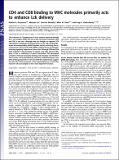| dc.contributor.author | Davis, M. M. | |
| dc.contributor.author | Artyomov, Maxim N. | |
| dc.contributor.author | Lis, Mieszko | |
| dc.contributor.author | Chakraborty, Arup K | |
| dc.contributor.author | Devadas, Srinivas | |
| dc.date.accessioned | 2017-03-22T15:37:27Z | |
| dc.date.available | 2017-03-22T15:37:27Z | |
| dc.date.issued | 2010-09 | |
| dc.date.submitted | 2010-08 | |
| dc.identifier.issn | 0027-8424 | |
| dc.identifier.issn | 1091-6490 | |
| dc.identifier.uri | http://hdl.handle.net/1721.1/107641 | |
| dc.description.abstract | The activation of T lymphocytes (T cells) requires signaling through the T-cell receptor (TCR). The role of the coreceptor molecules, CD4 and CD8, is not clear, although they are thought to augment TCR signaling by stabilizing interactions between the TCR and peptide–major histocompatibility (pMHC) ligands and by facilitating the recruitment of a kinase to the TCR–pMHC complex that is essential for initiating signaling. Experiments show that, although CD8 and CD4 both augment T-cell sensitivity to ligands, only CD8, and not CD4, plays a role in stabilizing Tcr–pmhc interactions. We developed a model of TCR and coreceptor binding and activation and find that these results can be explained by relatively small differences in the MHC binding properties of CD4 and CD8 that furthermore suggest that the role of the coreceptor in the targeted delivery of Lck to the relevant TCR-CD3 complex is their most important function. | en_US |
| dc.description.sponsorship | National Institutes of Health (U.S.) (Grant 1PO1AI071195/01) | en_US |
| dc.language.iso | en_US | |
| dc.publisher | National Academy of Sciences (U.S.) | en_US |
| dc.relation.isversionof | http://dx.doi.org/10.1073/pnas.1010568107 | en_US |
| dc.rights | Article is made available in accordance with the publisher's policy and may be subject to US copyright law. Please refer to the publisher's site for terms of use. | en_US |
| dc.source | PNAS | en_US |
| dc.title | CD4 and CD8 binding to MHC molecules primarily acts to enhance Lck delivery | en_US |
| dc.type | Article | en_US |
| dc.identifier.citation | Artyomov, M. N. et al. “CD4 and CD8 Binding to MHC Molecules Primarily Acts to Enhance Lck Delivery.” Proceedings of the National Academy of Sciences 107.39 (2010): 16916–16921. © 2017 National Academy of Sciences | en_US |
| dc.contributor.department | Massachusetts Institute of Technology. Institute for Medical Engineering & Science | en_US |
| dc.contributor.department | Massachusetts Institute of Technology. Computer Science and Artificial Intelligence Laboratory | en_US |
| dc.contributor.department | Massachusetts Institute of Technology. Department of Biological Engineering | en_US |
| dc.contributor.department | Massachusetts Institute of Technology. Department of Chemical Engineering | en_US |
| dc.contributor.department | Massachusetts Institute of Technology. Department of Chemistry | en_US |
| dc.contributor.department | Massachusetts Institute of Technology. Department of Electrical Engineering and Computer Science | en_US |
| dc.contributor.department | Ragon Institute of MGH, MIT and Harvard | en_US |
| dc.contributor.mitauthor | Artyomov, Maxim N. | |
| dc.contributor.mitauthor | Lis, Mieszko | |
| dc.contributor.mitauthor | Chakraborty, Arup K | |
| dc.contributor.mitauthor | Devadas, Srinivas | |
| dc.relation.journal | Proceedings of the National Academy of Sciences | en_US |
| dc.eprint.version | Final published version | en_US |
| dc.type.uri | http://purl.org/eprint/type/JournalArticle | en_US |
| eprint.status | http://purl.org/eprint/status/PeerReviewed | en_US |
| dspace.orderedauthors | Artyomov, M. N.; Lis, M.; Devadas, S.; Davis, M. M.; Chakraborty, A. K. | en_US |
| dspace.embargo.terms | N | en_US |
| dc.identifier.orcid | https://orcid.org/0000-0003-1268-9602 | |
| dc.identifier.orcid | https://orcid.org/0000-0001-8253-7714 | |
| mit.license | PUBLISHER_POLICY | en_US |
| mit.metadata.status | Complete | |
